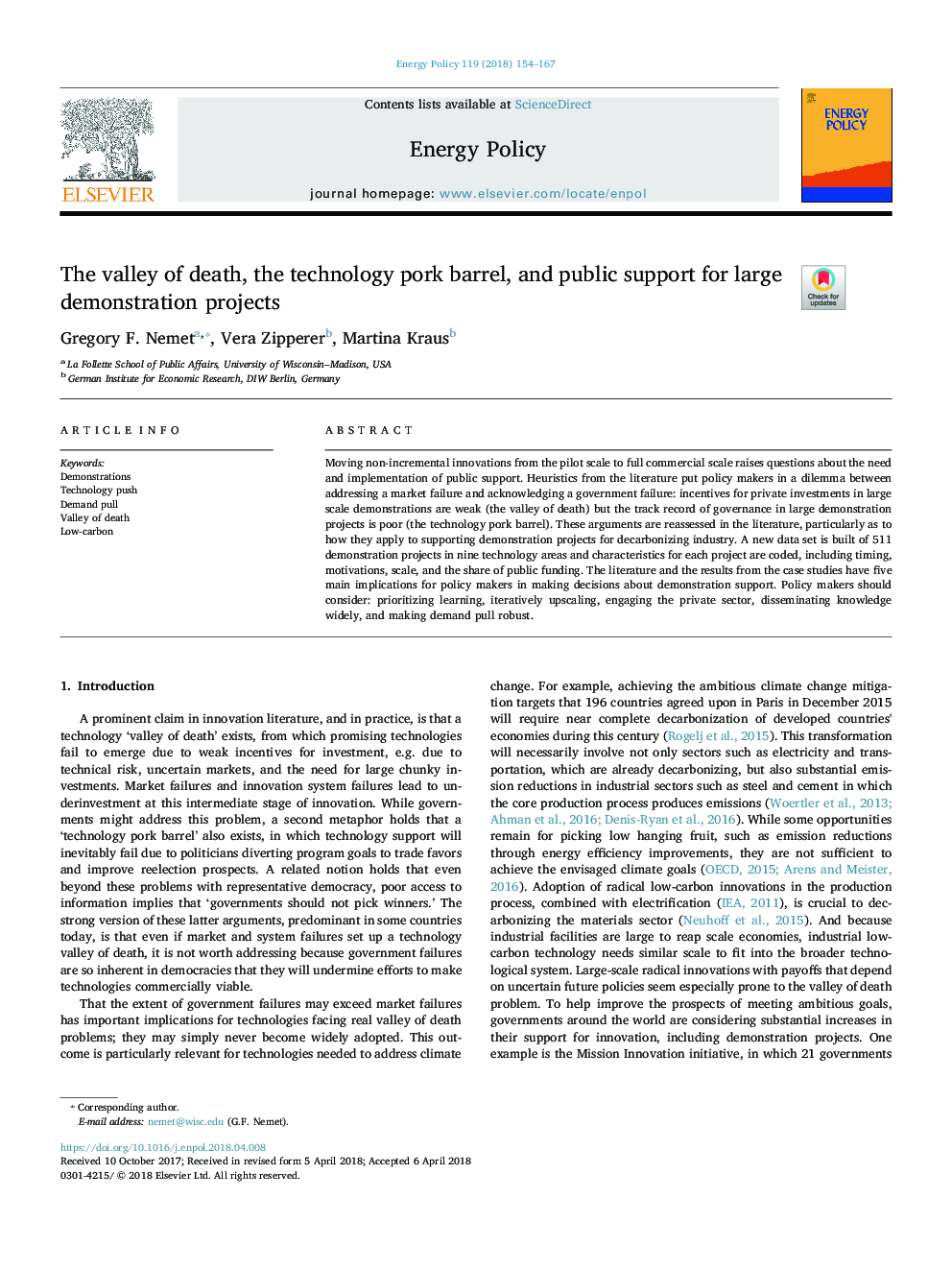| کد مقاله | کد نشریه | سال انتشار | مقاله انگلیسی | نسخه تمام متن |
|---|---|---|---|---|
| 7397158 | 1481239 | 2018 | 14 صفحه PDF | دانلود رایگان |
عنوان انگلیسی مقاله ISI
The valley of death, the technology pork barrel, and public support for large demonstration projects
ترجمه فارسی عنوان
دره مرگ، تکنولوژی گوشت خوک و پشتیبانی عمومی برای پروژه های بزرگ تظاهرات
دانلود مقاله + سفارش ترجمه
دانلود مقاله ISI انگلیسی
رایگان برای ایرانیان
کلمات کلیدی
تظاهرات، فشار فناوری، تقاضای کشیدن، دره مرگ، کم کربن،
ترجمه چکیده
حرکت نوآوری های غیر افزایشی از مقیاس آزمایشی به مقیاس تجاری کامل، سوالاتی در مورد نیاز و اجرای حمایت عمومی می کند. اکتشافات از ادبیات، سیاستگذاران را در معضلی بین نقص بازار و تصدیق شکست دولت قرار می دهند: انگیزه های سرمایه گذاری خصوصی در تظاهرات های بزرگ، ضعیف هستند (دره مرگ)، اما ضعف مدیریت در پروژه های بزرگ تظاهرات ضعیف است ( تکنولوژی گوشت خوک). این استدلال ها در ادبیات مجددا مورد ارزیابی قرار می گیرند، به خصوص اینکه چگونه برای حمایت از پروژه های تظاهرات برای کاهش تولید گازهای گلخانه ای در صنعت اعمال می شود. یک مجموعه داده جدید از 511 طرح تظاهرات در 9 منطقه فناوری ساخته شده است و ویژگی های هر کدام از پروژه ها کدگذاری شده اند، از جمله زمان بندی، انگیزه، مقیاس و سهم بودجه عمومی. ادبیات و نتایج مطالعات موردی پنج پیامد عمده برای سیاست گذاران در تصمیم گیری در مورد حمایت تظاهرات است. سیاستگذاران باید در نظر داشته باشند: اولویت دادن به یادگیری، تکرار ارتقاء، درگیر شدن در بخش خصوصی، انتشار دانش به طور گسترده و ایجاد تقاضا قوی است.
موضوعات مرتبط
مهندسی و علوم پایه
مهندسی انرژی
مهندسی انرژی و فناوری های برق
چکیده انگلیسی
Moving non-incremental innovations from the pilot scale to full commercial scale raises questions about the need and implementation of public support. Heuristics from the literature put policy makers in a dilemma between addressing a market failure and acknowledging a government failure: incentives for private investments in large scale demonstrations are weak (the valley of death) but the track record of governance in large demonstration projects is poor (the technology pork barrel). These arguments are reassessed in the literature, particularly as to how they apply to supporting demonstration projects for decarbonizing industry. A new data set is built of 511 demonstration projects in nine technology areas and characteristics for each project are coded, including timing, motivations, scale, and the share of public funding. The literature and the results from the case studies have five main implications for policy makers in making decisions about demonstration support. Policy makers should consider: prioritizing learning, iteratively upscaling, engaging the private sector, disseminating knowledge widely, and making demand pull robust.
ناشر
Database: Elsevier - ScienceDirect (ساینس دایرکت)
Journal: Energy Policy - Volume 119, August 2018, Pages 154-167
Journal: Energy Policy - Volume 119, August 2018, Pages 154-167
نویسندگان
Gregory F. Nemet, Vera Zipperer, Martina Kraus,
